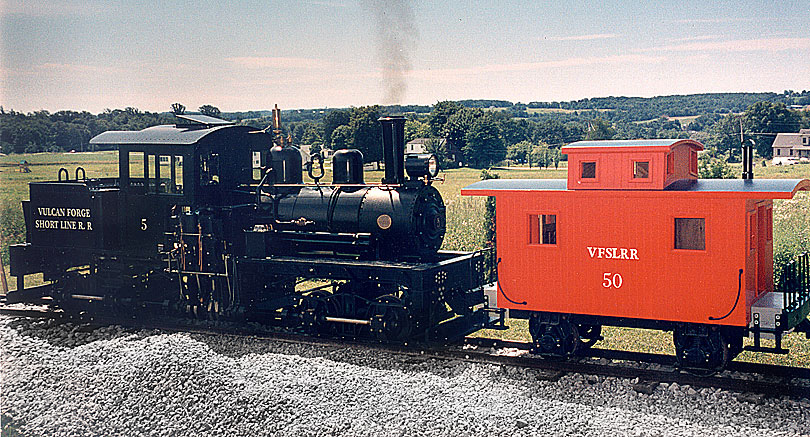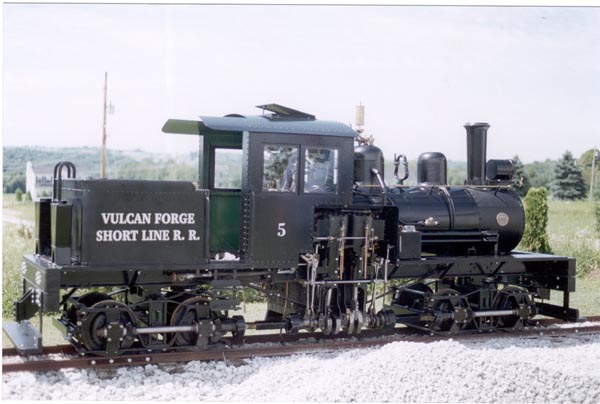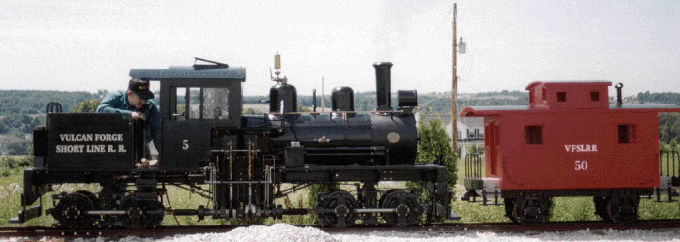|
Highlights (Parts of this section) |
|
|
This section of the I.N.G.N. will cover available options for powering a small railroad; from industrial 'Critters' to homebuilt gems. If our dear readers would like to add something to this page, please feel free to write! Of course 18-inch gauge is our specialty here, but being true 'rubber gaugers' we have many ideas and setups and would like to display yours here too.
Many of us with small railroads would love to 'move up' to REAL steam power, but this is often an expensive and time consuming task when 'critters', rebuildable park trains and homebuilt Internal Combustion locos seem to be plentiful and obtainable, if not inexpensive.
It seems that if steam locomotives were designed for simplicity and ease of manufacture while maintaining the 'class' and style inherent in steam engines, they could be built at a reduced cost compared to cutom manufactured scale models of complex prototypes. As was noted in a recent issue of Grand Scales Quarterly 'imagine what a home refridgerator would cost if each one had to be custom manufactured'. This seems to be the reasoning behind the efforts of Chris Allan and Hillcrest Shops with their Erich Thompson 'basic' 0-4-0 in 5 inch scale/ 15 inch gauge.
This effort has resulted in a beautiful, simple locomotiive that can be built on a modest budget, about the price of a nice brass HO or O scale locomotive! And my contention has always been; while brass is nice to look at, you can't ride it and you can't get the satisfaction of being moved by real steam power!
We have been thinking along the Porter or Forney lines for the first steam locomotive for our 18 inch gauge railroad and hadn't even considered another simple design that is as easy to build: A Shay geared locomotive. The article below about Tim Flood's shay really opened our eyes. It's simplicity of design - the chassis is basically a flatcar - is something that could easily be built without a lot of machine tools, heck we've built a bunch of flat cars already! The most difficult part of the design are the gear driven trucks (and these are a formidable challenge) but even these can be simplified to some extent.
The class 'A' type didn't even use driveshafts and geared axles, just chain drive. The popular 7 1/2" gauge 'Clishay' design of Live Steam magazine is of the class A type and there is an example of this in 15" gauge in Ohio. We are open to whatever design or class will work at this point as my brother already has two 5 1/2"x 6" cylinders and pistons, but nothing else. We might just design the rest as we go!
It all started with a question by the 'nefarious' : ) Ed Kelly of the Park Train Guide on the Parktrains list in August about building an inexpensive locomotive for fun:
From: gtngrr@---.com
Thinking of doing a homebuilt steam outline for fun...with no metalworking tools except a bandsaw and a welder.... I'd probably eventually build a track for it but with a brand new spacious shop out back I might as well take advantage of it.... The "boiler" is obviously a drum of some sort. I don't know where to find these but they're around. I'd do the frame myself. I'm better with wood than metal without a lathe or mill. Just trying to figure out the work involved and how easy/hard it would be to make. Of course, all of this would be done on a no more than $5000 budget. Thanks and Happy Rails,
Ed Kelley
Then like a shot out of the blue Tim Flood of Ohio responds:
From: "Tim Flood" <tflood@---.com>
Ed, You could probably build your project for much less than what you allowed in your budget - if you're good at scrounging materials. Believe it or not, I managed to build my 5" scale Shay for around $2000 out of pocket. Most machine work was done on a $50 scrap 17" lathe and a $250 scrap horizontal mill. The majority of parts were welded fabrications which were then ground and machined to look like castings. The project took a long time - but I too was on a budget.
Tim Flood
Needless to say we were all blown away by the suggestion that a machine of dreams could be built for such a price and the following photos and details really did the trick!

Mr. Flood provides some details of construction:
The gears are off the shelf Boston bevel gears. I realize they are not prototypical, but the price was right. I approached an industrial salesman who frequently calls on and sells large quantity items to the company I work for. One day, I ask him what the company's cost would be for these gears. Once I told him what I wanted them for - he simply gave them to me.
The single most expensive items were those used to fabricate the boiler, which is 18" in dia. The key is, can you wait long enough to find materials at a cost that you can afford?
Following are some specs:
Engine - Two cylinder 3" x 4" bore & stroke, with enough cylinder wall to increase bore to 4". Complete engine & crank are weld/fabrication. Crank throws 120 degrees apart.
Boiler - 18" dia. barrel; 31 1-1/4" dia. tubes; grate size approx. 16"x18". Fuel is wood; 150 psi operating pressure; all-welded construction, including steel grates.
Wheels - 11.88" dia., grey cast iron from my pattern.
Trucks - archbar w/brake beams and steel shoes machined from an ID OD burn-out.
Brakes - steam jams. Brake cylinder body from an old brass air cylinder; brake valve body cast from my pattern.
Overall Dimensions - 12'-4" OAL; 54" to top of cab roof. Loco weights approx. 2 tons.
Journals - axle and crank mains are babbit.

Tim continues:
One of the nice things about a Shay, besides the probability I could hook on to a rod loco and forcibly drag it anywhere I want, is the simplicity of construction. All you basically have is an I beam frame with a boiler sat on it and a self-contained engine bolted to the side. The wheels are independent except for the drive shaft and U-joints.

Such simplicity with a lot of homegrown engineering has resulted in a handsome and beautiful machine worthy of inclusion with the finest of the five inch scale group, at least from this online vantage point. It has inspired our efforts to build a working geared steam locomotive for our 18" gauge line as it may be easier than the rod locomotive we have been imagineering for some time.
This may be the beginning of a geared locomotive section of this publication investigating the many large locomotives of the type around the country and world. Any contributions by engineers of such kenetic works of steam artistry are welcome.
Contact: unknown1@myrealbox.com
posted 30.09.2002